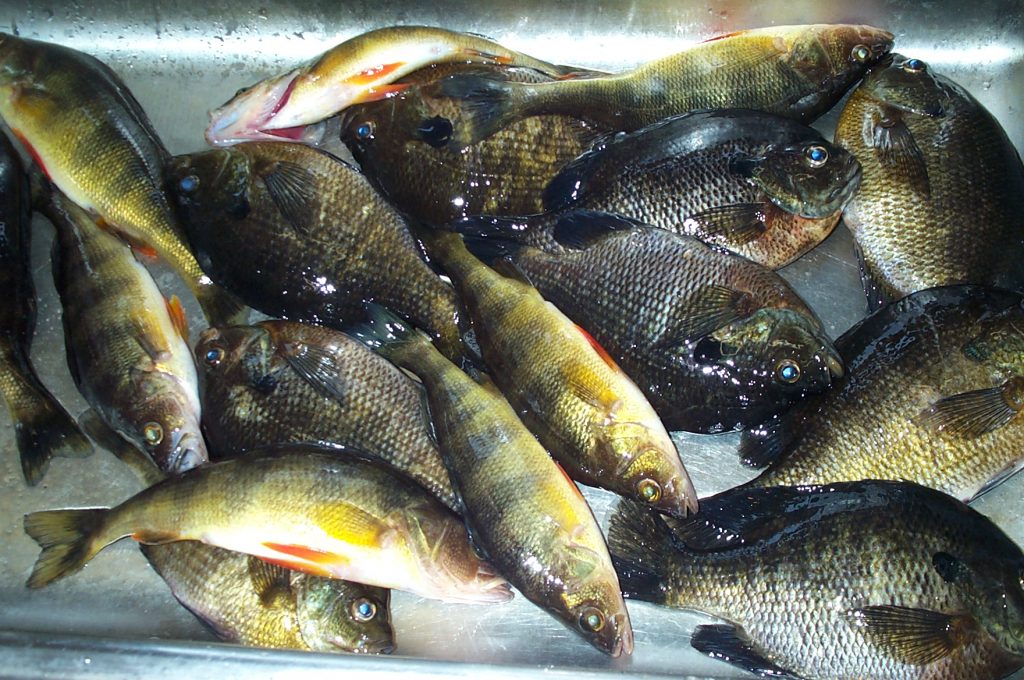
Every time we have a slow day on the water, maybe even take a sniff of the skunk’s hind end; it’s never our fault for choosing the wrong spot, poor lure choice or some other factor. Simply blame it on the weather. True to a point. The primary controlling factor in fish behavior is water temperature followed by other factors including light intensity, availability of prey, tides, sufficient cover or lack there of along with other things that can affect an anglers success on any given trip. These days with all the technological gizmos at our disposal, even a poor fisherman has the means to help make their success rate improve over time.
When conditions are right and the fish are active a finger cut off an old rubber glove on a hook can catch something, while other days nothing buys a strike.

Success boils down to a complex mix of experience, prevailing water and weather conditions and of course a smile from “Mother Luck” never hurts either.
I am rambling now because this has been such an odd winter and it is impossible to determine what Mother Nature will bring between now and April. This could not only be extreme weather, changes in regulations such as shortened seasons, different size and bag limits the economy, that stinking virus and other factors that could keep many anglers off the water.
As always anglers are suffering from cabin fever as winter wears on and eventually fades into spring. There is a simple, cheap solution that may help all but the most staunch big game marine anglers, fishing inland lakes and ponds that are open year round (consult the regulations before doing any fishing). Coastal rivers and estuaries used to provide some pretty good fishing on over-wintering striped bass, though that option has gone down hill over the past decade or so. The Thames River’s once great winter striper fishery has all but dried up. My long time fishing buddy takes the long ride to fish the Housatonic where there is a fishable population of stripers. I have made that ride only once and it was a slow day and I have opted to do other things rather than spend half a day in a car though my buddy has had some productive trips to there. I prefer to stay closer to home and if the waters are open head to smaller protected places to fish for perch and panfish, even though those same places also harbor bass, pike and other larger game species. Early spring is when I most enjoy catching some frying material in the form of sunfish and perch.
For decades, once the ice leaves coves, marina basins and back bay ponds on larger rivers, if accessible, I grab an ultra light rod, some small jigs, a dozen or so night crawlers and spend a few hours fishing for some frying material. My preference being yellow perch, though many people target white perch which are a relative of striped bass and also very tasty, plus they do grow a bit larger than the yellows. Both are small but abundant and aggressive species that I enjoy catching as much as eating.
In these areas where panfish, shiners and other small bait and prey species collect there are often predators on the prowl eating them for an easy meal. For most of the year my buddies and I target toothy predators, pike and muskellunge or bass in lakes that don’t have any pike. There are no muskellunge in Connecticut waters so when finances and time allows we make long range trip north, to the Ottawa River which holds pretty much all of the same freshwater species we have back home except for the one we do not. Muskellunge, potentially super sized muskies. These musky trips are long ten hour plus treks mostly on highways to areas along the St. Lawrence in the Montreal area. Early on we went to camp on the shores of Baker Lake, Maine and a few other places near the border with Quebec, and Nova Scotia, where we cut our teeth and occasionally fingers de-hooking these strong aggressive predators. That area did not produce the monsters we eventually began to dream of and later seek out. One year we hired a guide on the Ottawa River and got hooked on its potentially large toothy critters.
My first decent Connecticut pike was taken when it grabbed a small yellow perch I was reeling in at a marina basin during an early spring perch trip. That pike was about eight or nine pounds and was released, but it planted a seed of desire that grew and has blossomed into a full-blown quest for their larger cousins. It was a challenging fight because I hooked that pike on a tiny, micro ultra light rod I carry along on most freshwater trips specifically to catch some perch and sunfish for supper and the go to tool when a few panfish are all I want.
Ultra light gear is much more effective than even light bass tackle. All spring and summer there are always some night crawlers in my fridge where they can live for weeks. They always come along with my “dink rod” for local freshwater trips for those days when the bass and pike are not cooperating and sometimes simply to catch supper. The crawlers are cut into small pieces that are put on an 1/8th or 1/16th ounce chartreuse, yellow or white jig head and cast readily with the two pound test Fireline I use exclusively for what I call “dink fishing” with heavier test ratings on other spinning rigs for other, larger species. Some anglers hate the stuff; I never leave home without it.
Many a slow bass or pike outing has been saved by the dink rods and a few panfish. Every species has their attributes so I bring tackle appropriate for the size of the fish being targeted and the habitat they will be found in.
Years later in Mansfield Hollow which was stocked with pike by the state while “dink fishing” with that same little rod at the end of a very slow bass/pike trip a thirteen pound 38 or 39 inch northern decided to sample an inch long piece of worm, By sheer luck that fish had the hook stuck right in the tip of its snout or it surely would have broken off had the light line gone anywhere into that pin cushion like mouth.
Early perch action is quite simple as noted above. Using an ultra light spinning rod that has some stiffness to the blank which makes it more sensitive and easier to feel any thing at the other end and insure solid hook ups if a larger fish happens to take the offerings.
One of my long time fishing buddies and largemouth bass fishing mentor named Rennie taught me what I call “Rennie’s Rule number one”, (of many sage pieces of advise I call Renniessms) “never jig a jig”, because heavy jigging action may pull the lure away from an interested fish. Rennie’s reasoning was the act of reeling, movement in the boat or simple small movements of the rod tip impart fish attracting action without jeopardizing a potential, unseen strike. In cold water fish don’t want to expend too much effort to get a meal so retrieves must be slow and methodical.
Set the hook immediately at the slightest resistance or any kind of tap, tap at the other end. This serves two purposes. Generally the fish is lip hooked so if it is not a desired species or maybe a little too small it can be released with minimal damage. Better to release them with a little hole in their lip than killing a gut hooked fish that may be a tad too small to keep.
I fillet everything I eat, one claim to fame is “I can fillet a guppy” which is a blatant lie, not due to the size but because they have those “Y” bones like a shad which makes it impossible even for a self professed surgeon with a fillet knife. I have the scars to prove it, but the great frying material is worth the effort and occasional blood letting.
I seldom kill pike or pickerel because they like all top predators are important for a balanced ecosystem in both woods and waters. However, if one gets gut or gill hooked and will likely die I do keep them to eat rather than risk putting a dying fish back in the water. They taste great but so do the dink species, which are more abundant.
On the rare occasion when I do have a pike or pickerel on the fillet board at home I have a method to fillet around those pesky “Y” bones. I take both sides off the fish like it was any other less boney species, cutting through the “Y” bones in the process. Then the fillet is skinned and laid on the board where with finger tips those fine bones can be felt in rows on each fillet. The fillet is essentially cut into strips, the meat in the “V” shaped strips can be cut out so the fillet ends up being four boneless strips per side. Once you perfect the technique very little meat is wasted. I hate bones in my fish plus its better than having some one choke on a small bone that comes out of a whole small fish or cooked fillet with “Y” bones left in.
Last step before heating up the frying pan is to make an egg and milk batter, wetting the fillets and coating with flour or corn meal. Place the coated fillets to dry on paper towels before cooking. Sometimes a second dip in the batter and coating is necessary to completely coat the fillet. Heat a skillet with butter or oil, fry until golden brown and serve with your favorite side dishes and condiments.
Tapping out this article is making me yearn for ice out and fresh batch of yellow perch fillets waiting to be fried for supper.
